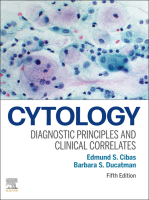Physical Address
304 North Cardinal St.
Dorchester Center, MA 02124

In the United States, the cytology laboratory is one of the most regulated of all the laboratories involved in clinical testing. To effectively manage and work in a cytology laboratory, personnel must be familiar with the relevant regulatory agencies and…

Introduction Primary bone tumors are relatively common, and the majority are benign and clinically silent. Bone lesions that have a characteristic radiologic appearance or are predominantly sclerotic, such as osteochondroma and fibrous dysplasia, are monitored clinically and radiologically and are…

Few areas in cytology arouse such passionate discourse as fine-needle aspiration (FNA) of soft tissue masses. Critics jump at the opportunity to point out the limitations of the technique but pose few valid arguments along with outdated fallacies and academic…

Fine-needle aspiration (FNA) is a safe, minimally invasive, and relatively inexpensive procedure for the diagnosis of selected ovarian lesions. Indications for fine-needle aspiration of the ovary Confirm the benign nature of an incidental cyst discovered during: An infertility workup Pregnancy…

The Kidney Indications and Sampling Methods Fine-needle aspiration (FNA) of the kidney is a useful technique for the diagnosis of selected renal lesions. FNA, as it turns out, is not necessary for most renal masses. In adults, the great majority…

Indications An unexplained pancreatic mass and a bile duct stricture are the major indications for cytologic evaluation of the pancreas and bile ducts. Imaging studies contribute useful information on the location, distribution (solitary, multiple, or diffuse), and nature (cystic vs…

Fine-needle aspiration (FNA) and small core needle biopsy are mainstays in the evaluation of liver masses. They are usually performed percutaneously with guidance by computed tomography (CT), ultrasonography, or magnetic resonance imaging (MRI), and its principal value is in the…

Enlarged lymph nodes are a prime target for fine-needle aspiration (FNA). In an adult, lymph nodes greater than 1 to 2 cm are an immediate source of concern, and, unless the cause is evident, the enlarged node should be aspirated.…

Rationale, Indications, and Technical Considerations Any unexplained salivary gland mass is an indication for fine-needle aspiration (FNA). FNA is the preferred biopsy method because incisional biopsy is associated with an increased risk of infection and potential contamination of surgical planes.…

Discovering a thyroid nodule in a patient raises the specter of malignancy. The usual workup includes an ultrasound examination, followed by fine-needle aspiration (FNA) if the nodule meets biopsy criteria. Thyroid nodules are very common, although the prevalence depends on…